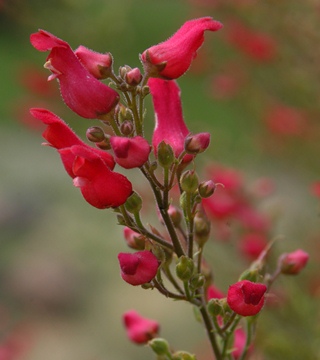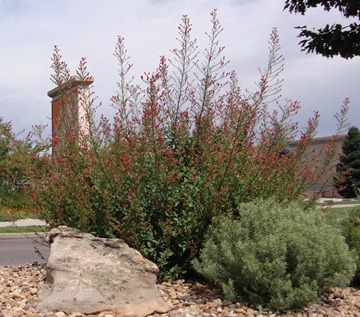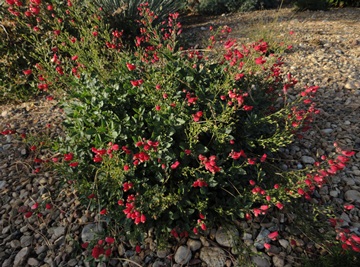Hummingbird magnets: "Red birds in a tree"
 Anyone who has managed to grow "Red birds in a tree" knows that few plants are more attractive to hummingbirds. Scrophularia macrantha is a very local plant endemic largely to a few mountains in central New Mexico. The genus usually goes by the common name "Figwort" and gave its name to the Figwort Family--(Scrophulariaceae), which opens up another can of worms--let's leave that for another blog! But this plant is notable for several reasons: it is unquestionably the queen bee of its genus (Scrophularia is widespread in the old world, where most species are black or brown flowered--charming, I'm sure!). It makes a striking specimen in a border or wild garden--but stand back! It can grow six or more feet tall in gardens. T
Anyone who has managed to grow "Red birds in a tree" knows that few plants are more attractive to hummingbirds. Scrophularia macrantha is a very local plant endemic largely to a few mountains in central New Mexico. The genus usually goes by the common name "Figwort" and gave its name to the Figwort Family--(Scrophulariaceae), which opens up another can of worms--let's leave that for another blog! But this plant is notable for several reasons: it is unquestionably the queen bee of its genus (Scrophularia is widespread in the old world, where most species are black or brown flowered--charming, I'm sure!). It makes a striking specimen in a border or wild garden--but stand back! It can grow six or more feet tall in gardens. T This monumental specimen is growing on Alameda, in Lakewood's amazing median strips that are filled with choice xeric plants. I nearly had an accident the first time I saw this growing here--such a rare plant, in the middle of a busy street! Lakewood can be proud indeed...
This monumental specimen is growing on Alameda, in Lakewood's amazing median strips that are filled with choice xeric plants. I nearly had an accident the first time I saw this growing here--such a rare plant, in the middle of a busy street! Lakewood can be proud indeed...  Here is a compact form that popped up a few years ago in the Lakewood Showcase garden on Hoyt and Jewel (the "Gardens at Kendrick Lake": if you have not been there, hightail it out there pronto: it is a stunning xeriscape demonstration garden that looks good at all times). I collected a pinch of seed of this twenty years ago exactly this August at about 6000' in Luna County, New Mexico on an expedition with my brother-in-law, Allan Taylor to get seed off the northernmost Arizona Cypress in New Mexico. There was only one plant of the Scrophularia, and it was in seed: I sent a smidge to Kew and shared the rest with a few friends. David Salman of High Country Gardens was the first to successfully grow and market the plant, and he gave it its wonderful common name. In 1998 it received the Green Thumb Award of the mail order nursery association. Ten years later it was promoted by Plant Select, and today nurseries across the world sell this plant, so rare in nature but treasured in gardens. We have been finding hummingbirds in Denver area gardens all summer in recent years (they used to only pass through on the way to the mountains in spring and fall). More intriguingly, their numbers swell enormously in dry years like this year: I sometimes wonder if the vast array of red flowered, hummingbird-pollinated plants in Plant Select (a bevy of Salvia, penstemons galore, Agastache spp. and this Scrophularia) are not providing such a smorgasbord of delights for them that they find lingering down here attractive. I know that when flowers are sparse or absent in the hills, our gardens may be providing a vital food source for these miniature avian gems--a fascinating unintended consequence of our plant exploration. Pretty cool, no?
Here is a compact form that popped up a few years ago in the Lakewood Showcase garden on Hoyt and Jewel (the "Gardens at Kendrick Lake": if you have not been there, hightail it out there pronto: it is a stunning xeriscape demonstration garden that looks good at all times). I collected a pinch of seed of this twenty years ago exactly this August at about 6000' in Luna County, New Mexico on an expedition with my brother-in-law, Allan Taylor to get seed off the northernmost Arizona Cypress in New Mexico. There was only one plant of the Scrophularia, and it was in seed: I sent a smidge to Kew and shared the rest with a few friends. David Salman of High Country Gardens was the first to successfully grow and market the plant, and he gave it its wonderful common name. In 1998 it received the Green Thumb Award of the mail order nursery association. Ten years later it was promoted by Plant Select, and today nurseries across the world sell this plant, so rare in nature but treasured in gardens. We have been finding hummingbirds in Denver area gardens all summer in recent years (they used to only pass through on the way to the mountains in spring and fall). More intriguingly, their numbers swell enormously in dry years like this year: I sometimes wonder if the vast array of red flowered, hummingbird-pollinated plants in Plant Select (a bevy of Salvia, penstemons galore, Agastache spp. and this Scrophularia) are not providing such a smorgasbord of delights for them that they find lingering down here attractive. I know that when flowers are sparse or absent in the hills, our gardens may be providing a vital food source for these miniature avian gems--a fascinating unintended consequence of our plant exploration. Pretty cool, no?
Comments
Red Bird in a Tree -
Can this plant be clipped back during the growing season to keep it at a shorter heights? If so where do you cut the stems?
Red Birds in a tree
If it's growing vigorously, you can certainly cut it back quite hard. Tip pruning is best early on however. It's relatively new to culture so we're all learning how to grow it!
Deer?
I have 2 plants that have survived Bath County VA wacky weather and look lovely -- do deer like them? If so, I will put them in containers. Thank you. Pat
Cut back on the fall?
Hello! I just bought one over mothers day. I'm wondering did I'm supposed to cut it back in the fall and how short?
Red birds in a tree
I wouldn't cut it back very far in the fall: treat it like lavender and cut in March is best I think. It's from southern New Mexico and needs top growth in winter to protect the crown.
Trimming Red Birds in a Tree
Yes, I read that you should wait until Spring to cut back the stems. Cut back to about 3 inches. I think I read that on the High Country Garden website.
Redbirds and tremendous rain
We have had over 8 inches of rain in 24460 in a little over 2 weeks. Horrible. They are looking good so far (my lavender is showing internal rot). I have decided not not mulch yet because the soil is saturated and pooling on top in some places. Is this a wise decision on my part?
Red Birds dying?
Our Red Birds in a Tree are about 4-feet tall and have been looking great. All of a sudden, however, they started wilting and appear to be dying. Any suggestions? Thanks
I have this plant thriving in
I have this plant thriving in 5-6 hours of sun at 8400' (Trout Creek, Teller County) and the deer leave it alone!
Red Birds in a Tree plants
I bought 2 tiny plants online and the next year, out of the blue I discovered that there were at the least 6 of them. They seem to "self seed" to propagate. I am very excited and curious to see if they have survived the crazy winter in the Denver area.
Support staking
My plant lays on the ground. Is it okay to support upright with a support stake? Thanks.
Support staking
Yes, I have supported the Red Birds in a Tree. Last year it was "catch up" and it was supporting main branches individually. This year I used a tomato plant support cone. It works great. The plant is as high as the fence (5 ft.). It works great but my neighbors honeysuckle seems to be great competition.
Plant is drying up
My Red Birds in a Tree plant looks like it's drying up suddenly in Longmont CO. This is the end of the second season of full, healthy growth, but almost overnight end of August it's drying up and looks like it's dying. I don't remember this happening last fall. Any suggestions? I read that they don't have a long lifespan, but I expected more that two growing seasons. It gets full sun all day and I water almost every day. Too much water? Not enough? Disease? I love this plant and hate to lose it.
Red Birds in a Tree drying up?
It appears that my Red Birds In a Tree is comming to the end of its blooming season. At least it doesn't seem to have a lot of new buds that appeal to the humming birds. I have been conscious to not overwater as I had read that they fare better in dryer climates. Perhaps you have given it more water than it needs. I too have read that they don't have a long lifespan. I don't know what that means. I think this is the third year for my plant. I have another first year plant in another area. I have wondered about all the blooms that are followed by what look like seeds, but have not seen any new plants. I think I tried to plant one last fall, but it didn't survive although the nursery expert said that she had success with some fall plantings. My suggestion would be to take a photo of the plant and send it to High Country Gardens and ask them what they think. I've never tried it but it might be worth a try. I think they were original nursery to sell this plant.
Red Bird in a Tree drying up
Thanks, Gary. I think I lost my plant. It continued to dry and shrivel up and then it looked like the root had rotted. So I'm thinking I overwatered it in spite of my best intentions. Don't know if any part of the root was salvaged and I may have a plant next spring, but I'm not expecting it. I will get another and place it it a better location. It's a lovely plant.
Red Birds in a Tree
A few years ago I purchased a few plants from High Country Gardens and up to yesterday I still had Humming birds feeding on them. In November I will order some more for my daughter. I have many Humming birds/bees/butterfly attracting plants but none are like these plants.
Add new comment